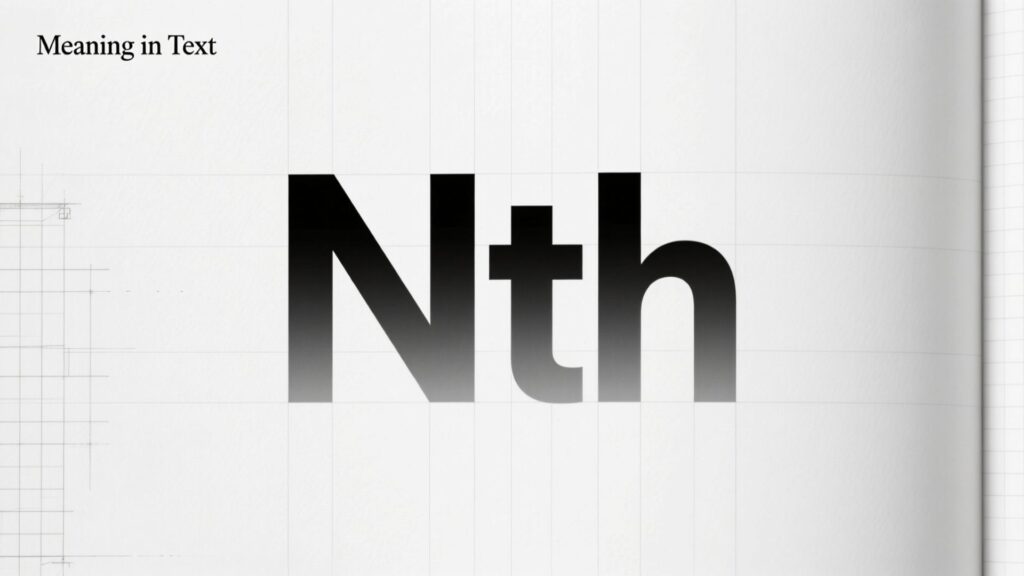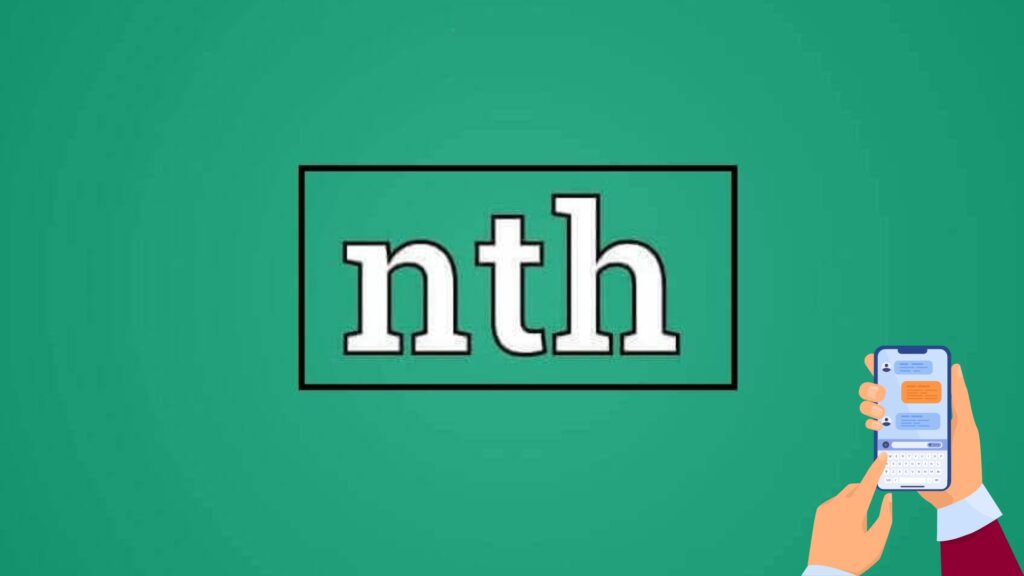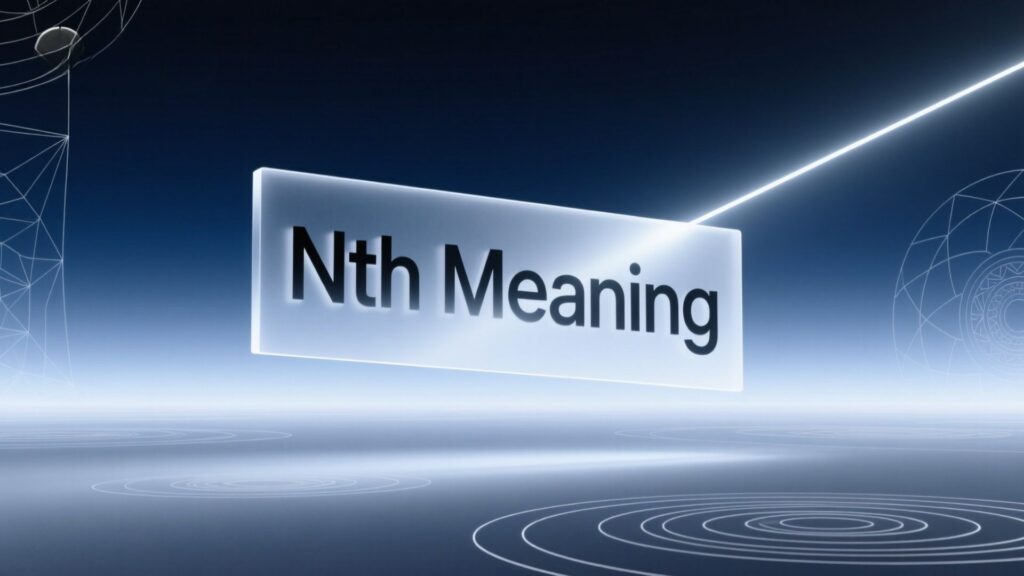In today’s fast-paced digital world, abbreviations and shorthand dominate conversations. Among these, “Nth” has grown increasingly common in texting, social media, and even professional settings. But do you really know what does nth mean texting and how to use it correctly? This guide explores everything from its mathematical origins to real-world usage, alternatives, tone considerations, and practical examples.
Quick Definition and Nutshell Explanation

The term “Nth” stands for an unspecified ordinal number. In mathematics, it represents a generic position in a sequence. For example, in the sequence 1, 2, 3… the “n-th term” can refer to any position, depending on the value of n.
In texting and casual writing, nth meaning text has shifted from precise mathematics to a rhetorical device. People use it to emphasize repetition, frustration, or exaggeration. For instance:
“This is the nth time you’ve forgotten your password!”
Here, “nth” doesn’t point to an exact number. Instead, it communicates repeated events without specifying exactly how many.
Understanding this distinction is essential for choosing when and how to use nth in texting correctly.
Short History and Linguistic Origin
The phrase “nth” originates from algebra, where n represents an arbitrary number, and the -th suffix marks an ordinal. Mathematicians historically used it to describe sequences, series, or general cases without specifying exact positions.
Over time, English speakers borrowed the term for colloquial use, especially to express repetition or countless occurrences. It now appears in:
- Text messages and chat apps
- Social media posts
- Informal emails
- Blogs and casual writing
By understanding its roots, you’ll know why nth meaning text carries both precision in math and exaggeration in casual speech.
Two Cores: Mathematical Origin and Colloquial Drift
Mathematical usage:
- Denotes a specific yet arbitrary position in a sequence.
- Used in formulas, algorithms, and technical explanations.
- Example: “The n-th term of the sequence is aₙ = 2n + 3.”
Colloquial usage:
- Signifies repeated actions or events, often exaggerating.
- Adds rhetorical emphasis in conversation.
- Example: “I’ve told you for the nth time to check your email!”
The key is recognizing context. Use nth meaning text carefully in professional writing to avoid confusion between precise and exaggerated meanings.
When to Use “Nth” in Text — Clear Rules
Using nth in texting correctly depends on the audience, platform, and purpose:
- Casual conversations: Texts, chats, and social media posts are ideal. “This is the nth time I’ve reminded you about the meeting.”
- Rhetorical emphasis: To stress frustration or repetition.
- Code comments or technical notes: When referring to an unspecified sequence or placeholder variable. “Retrieve the n-th element from the array.”
- Mathematical or academic contexts: Use the hyphenated “n-th” form for clarity.
Tip: Avoid ambiguity. If the context requires precision, spell out the exact number instead of relying on “nth.”
When Not to Use “Nth” — Concrete Alternatives
Despite its popularity, nth meaning text isn’t always appropriate:
- Formal documents: Reports, contracts, and research papers.
- Professional emails: Clarity is critical; avoid idiomatic shorthand.
- International communication: Non-native speakers may misinterpret “nth.”
Instead, choose alternatives that match tone, audience, and clarity.
Examples of clear alternatives:
- Repeatedly
- Time and again
- Many times
- Countless times
- For the umpteenth time
Alternatives Ranked by Formality and Clarity
Here’s a table showing common replacements for nth meaning text and their ideal context:
| Alternative Phrase | Formality | Best Context | Concision |
|---|---|---|---|
| n-th | High | Mathematics, technical papers | Very concise |
| On the nth occasion | Medium | Technical, semi-formal writing | Concise |
| Repeatedly | Medium | Neutral prose | Short |
| Many times | Low | Casual or conversational | Short |
| For the umpteenth time | Very Low | Informal, idiomatic speech | Emphatic |
| Time and again | Low | Emphatic yet polite | Short |
This table helps you pick an alternative depending on the tone and clarity needed.
Platform-Specific Guidance

Different communication channels affect how you should use nth meaning text:
- SMS and chat apps: Acceptable and widely understood.
- Social media posts: Works for relatability and brevity.
- Emails to colleagues: Prefer explicit phrasing for clarity.
- Academic writing: Always use “n-th” with formal variable definitions.
- Code or programming comments: “nth” or “n-th” works; maintain consistency.
Tone, Audience, and Cultural Considerations
Using nth in texting requires attention to context:
- Youth audiences: Comfortable with idioms and exaggeration.
- Professional readers: Expect clarity; avoid shorthand.
- International readers: May misunderstand informal meanings.
- Legal or official documents: Must rely on explicit numbers or neutral phrasing.
Pro tip: When in doubt, clarity beats style.
Punctuation, Capitalization, and Style Rules
Follow these rules for correct usage:
- Capitalize only at sentence starts or proper nouns.
- Hyphenate “n-th” in formal or technical contexts.
- Avoid commas before coordinating conjunctions joining independent clauses.
- Treat “nth” like a variable in technical writing.
Example:
Correct: “Let aₙ represent the n-th term in the sequence.”
Incorrect: “Let aₙ represent the nth term, in the sequence.”
Ready-to-Use Sentence Templates and Swaps
Templates make it easier to incorporate nth meaning text naturally:
| Template | Swap Example |
|---|---|
| “This is the nth time [clause].” | “This is the tenth time we tried contacting you.” |
| “For the nth time, please [verb].” | “For the umpteenth time, please submit the report.” |
| “Let the nth term be [expression].” | “Let the n-th term be 2n + 3.” |
20 Real Example Sentences Across Registers
Casual texting:
- “This is the nth time I’ve told you to check your messages.”
- “Ugh, the app crashed for the nth time today.”
Blog or informal writing:
3. “For the nth time, backup your data before updating.”
4. “I’ve visited this café the nth time, and it never disappoints.”
Professional email:
5. “We encountered this issue repeatedly in Q3 reports.”
6. “This problem has arisen on numerous occasions and requires attention.”
Technical or code writing:
7. “Retrieve the n-th element from the array using a loop.”
8. “The algorithm calculates the n-th Fibonacci number efficiently.”
Legal or official documentation:
9. “Repeated breaches occurred on numerous occasions.”
10. “Time and again, the clauses were violated.”
Additional examples for casual, technical, and professional contexts:
11. “I’ve reminded you for the umpteenth time about the deadline.”
12. “Time after time, users reported login issues.”
13. “Endlessly, the script ran without errors.”
14. “Perpetually, the service experienced downtime during peak hours.”
15. “Again and again, the experiment yielded similar results.”
16. “Frequently, system updates interfere with application performance.”
17. “Habitually, the user ignored notifications.”
18. “At every turn, the software provided helpful tips.”
19. “On numerous occasions, the client requested clarifications.”
20. “Repeatedly, the manager emphasized compliance with protocol.”
Common Mistakes and How to Fix Them
- Mistake: Using “nth” in formal reports.
Fix: Replace with explicit phrasing or ordinal numbers. - Mistake: Mixing numeric and colloquial meanings.
Fix: Clarify whether you mean a variable (math) or rhetorical exaggeration. - Mistake: Missing hyphen in technical contexts.
Fix: Use “n-th” consistently for formal writing. - Mistake: Using “nth” with non-native readers without explanation.
Fix: Substitute with “many times” or another clear alternative.
Quick Reference Cheat Sheet
- Fast clarity: Use “many times” or a precise number.
- Formal math or technical context: Use “n-th” with variable definition.
- Casual speech: Use idioms like “for the umpteenth time” or “time and again.”
- Code: Keep “nth” consistent, and comment clearly.
SEO, Title, and Meta Suggestions for 2025
Primary Title:
Nth Meaning in Text: What It Means and How to Use It Right (2025)
Alternate Titles:
- “What Does Nth Mean in Texting? Complete 2025 Guide”
- “Nth Meaning Text Explained with Examples”
Meta Description (19–20 words):
“Learn what ‘Nth’ means, when to use it, and clear alternatives for formal, casual, and technical writing.”
Keywords naturally incorporated:
- what does nth mean texting
- nth meaning text
- what does nth mean in texting
- what does nth mean in text
- what do nth mean in text
FAQ — Short Answers to Typical Questions
Q: Is “nth” acceptable in academic writing?
A: Use “n-th” with variable definition instead for clarity.
Q: Does “nth” mean an exact number?
A: No, it represents an unspecified ordinal, often exaggerated in casual speech.
Q: Should translators keep “nth”?
A: Translate to a clear equivalent appropriate for the audience and context.
Q: Can “nth” be used in professional emails?
A: Only if rhetorical emphasis is necessary; otherwise, prefer explicit alternatives.
Conclusion and Best Practice Checklist
- Prioritize clarity: Only use “nth” if your audience understands it.
- Match audience, tone, and platform: Informal vs formal communication matters.
- Use alternatives when needed: “Repeatedly,” “time and again,” or explicit numbers work best.
- Follow punctuation and hyphen rules: “n-th” in technical contexts; avoid extra commas.
- Practice with templates and examples: Helps internalize correct usage.
Final tip: Mastering nth meaning text isn’t just about shorthand. It’s about using the right word in the right context, every time. By understanding origins, tone, and alternatives, you’ll write clearer, smarter, and more engaging messages.
Bugti is the founder of Quoethint.com, a hub for English language tips, writing advice, and grammar guidance. With years of experience in English studies and a passion for clear communication, Bugti created this platform to make grammar and writing easy to understand for everyone.
